(完整版)高考英语语法专题复习分类汇编-定语从句与状语从句,推荐文档
- 格式:docx
- 大小:216.72 KB
- 文档页数:7
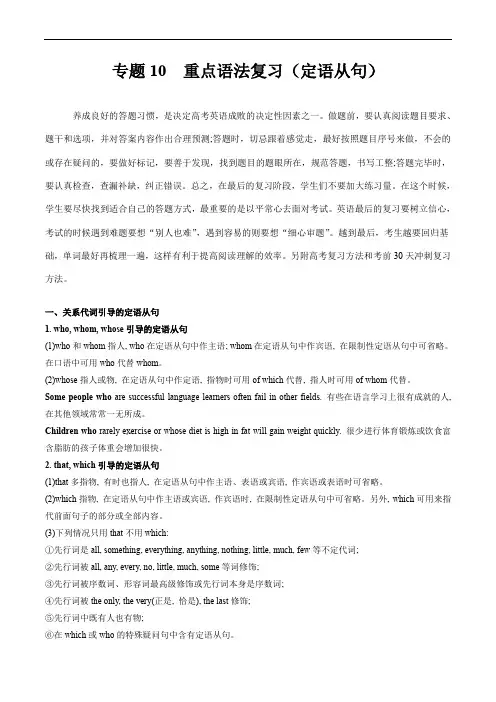
专题10 重点语法复习(定语从句)养成良好的答题习惯,是决定高考英语成败的决定性因素之一。
做题前,要认真阅读题目要求、题干和选项,并对答案内容作出合理预测;答题时,切忌跟着感觉走,最好按照题目序号来做,不会的或存在疑问的,要做好标记,要善于发现,找到题目的题眼所在,规范答题,书写工整;答题完毕时,要认真检查,查漏补缺,纠正错误。
总之,在最后的复习阶段,学生们不要加大练习量。
在这个时候,学生要尽快找到适合自己的答题方式,最重要的是以平常心去面对考试。
英语最后的复习要树立信心,考试的时候遇到难题要想“别人也难”,遇到容易的则要想“细心审题”。
越到最后,考生越要回归基础,单词最好再梳理一遍,这样有利于提高阅读理解的效率。
另附高考复习方法和考前30天冲刺复习方法。
一、关系代词引导的定语从句1. who, whom, whose引导的定语从句(1)who和whom指人, who在定语从句中作主语; whom在定语从句中作宾语, 在限制性定语从句中可省略。
在口语中可用who代替whom。
(2)whose指人或物, 在定语从句中作定语, 指物时可用of which代替, 指人时可用of whom代替。
Some people who are successful language learners often fail in other fields. 有些在语言学习上很有成就的人, 在其他领域常常一无所成。
Children who rarely exercise or whose diet is high in fat will gain weight quickly. 很少进行体育锻炼或饮食富含脂肪的孩子体重会增加很快。
2. that, which引导的定语从句(1)that多指物, 有时也指人, 在定语从句中作主语、表语或宾语, 作宾语或表语时可省略。
(2)which指物, 在定语从句中作主语或宾语, 作宾语时, 在限制性定语从句中可省略。
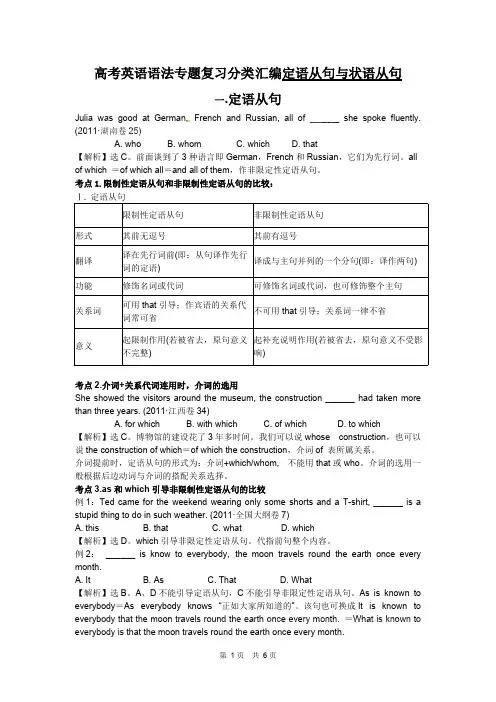
高考英语语法专题复习分类汇编定语从句与状语从句一.定语从句Julia was good at German,French and Russian, all of ______ she spoke fluently. (2011·湖南卷25)A. whoB. whomC. whichD. that【解析】选C。
前面谈到了3种语言即German,French和Russian,它们为先行词。
all of which =of which all=and all of them,作非限定性定语从句。
考点1.限制性定语从句和非限制性定语从句的比较:Ⅰ. 定语从句限制性定语从句非限制性定语从句形式其前无逗号其前有逗号翻译译在先行词前(即:从句译作先行词的定语)译成与主句并列的一个分句(即:译作两句)功能修饰名词或代词可修饰名词或代词,也可修饰整个主句关系词可用that引导;作宾语的关系代词常可省不可用that引导;关系词一律不省意义起限制作用(若被省去,原句意义不完整)起补充说明作用(若被省去,原句意义不受影响)考点2.介词+关系代词连用时,介词的选用She showed the visitors around the museum, the construction ______ had taken morethan three years. (2011·江西卷34)A. for whichB. with whichC. of whichD. to which【解析】选C。
博物馆的建设花了3年多时间。
我们可以说whose construction,也可以说the construction of which=of which the construction,介词of 表所属关系。
介词提前时,定语从句的形式为:介词+which/whom, 不能用that或who。
介词的选用一般根据后边动词与介词的搭配关系选择。
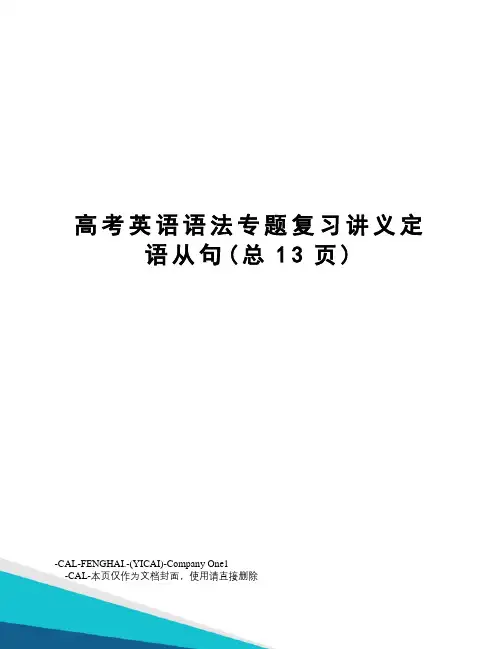
高考英语语法专题复习讲义定语从句(总13页)-CAL-FENGHAI.-(YICAI)-Company One1-CAL-本页仅作为文档封面,使用请直接删除高考英语语法专题复习经典讲义定语从句定语从句及相关术语1.定语从句:定语从句是由关系代词或关系副词引导的从句,其作用是作定语修饰主句的某个名词性成分,相当于形容词,所以又称为形容词性从句,一般紧跟在它所修饰的先行词后面。
2.关系词:引导定语从句的关联词称为关系词,关系词有关系代词和关系副词。
关系代词有that, which, who, whom, whose, as等;关系副词有where, when, why等。
关系词常有3个作用:1,引导定语从句。
2,代替先行词。
3,在定语从句中担当一个成分。
注:关系代词有主语.宾语之分。
一般whom作为宾语。
4.定语:定语用来限定、修饰名词或代词的,是对名词或代词起修饰、限定作用的词、短语或句子,汉语中常用‘……的’表示。
主要由形容词担任。
此外,名词,代词,数词,分词,副词,不定式以及介词短语也可以来担任,也可以由一个句子来担任.单词作定语时通常放在它所修饰的词之前,作前置定语。
短语和从句作定语时则放在所修饰的词之后,作后置定语。
先行词:被定语从句修饰的名词、代词称为先行词。
(一)限定性定语从句一、关系代词(在句中作主语、宾语或定语)1. that既可代表事物也可代表人,which代表事物;它们在从句中作主语或宾语,that在从句中作宾语时常可省略关系词,which在从句中作宾语也可以省略。
2而且,如果which在从句中作“不及物动词+介词”的介词的宾语,注意介词不要丢掉,而且介词总是放在关系代词which的前边,但有的则放在它原来的位置3. 代表物时多用which,但在带有下列词的句子中用that而不用which,这些词包括当先行词是anything, everything, nothing , none等不定代词时,或者是由every, any, all, some, no, little, few, much等修饰时等,这时的that常被省略还有先行词前有序数词或形容词最高级修饰时,或先行词就是序数词或最高级时.以及先行词中既有人又有物时.还有句中前面有which 时,都只能用that4. who和whom引导的从句用来修饰人,分别作从句中的主语和宾语,whom作宾语时,要注意它可以作动词的宾语也可以作介词的宾语5. whose是关系代词,修饰名词作定语,相当于所修饰成分的前置所有格.它引导的从句可以修饰人和物, 当它引导的从句修饰物体时, 可以与 of which 调换,表达的意思一样。
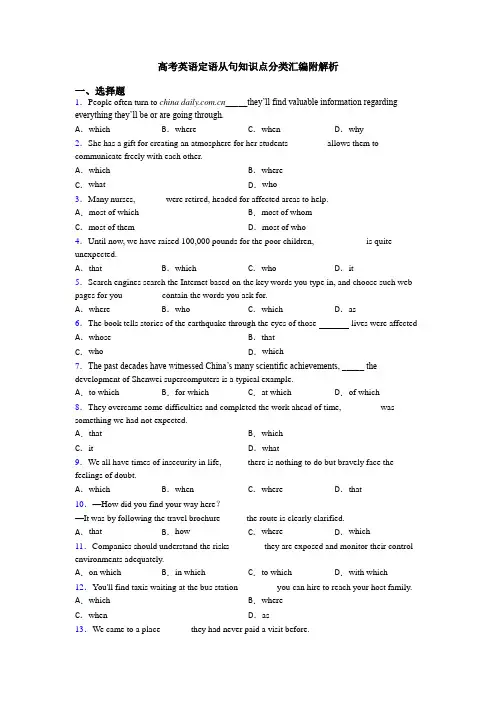
高考英语定语从句知识点分类汇编附解析一、选择题1.People often turn to china _____they’ll find valuable information regarding everything they’ll be or are going through.A.which B.where C.when D.why2.She has a gift for creating an atmosphere for her students ________ allows them to communicate freely with each other.A.which B.whereC.what D.who3.Many nurses, ______ were retired, headed for affected areas to help.A.most of which B.most of whomC.most of them D.most of who4.Until now, we have raised 100,000 pounds for the poor children, ___________ is quite unexpected.A.that B.which C.who D.it5.Search engines search the Internet based on the key words you type in, and choose such web pages for you ________ contain the words you ask for.A.where B.who C.which D.as6.The book tells stories of the earthquake through the eyes of those lives were affected A.whose B.thatC.who D.which7.The past decades have witnessed China’s many scientific achievements, _____ the development of Shenwei supercomputers is a typical example.A.to which B.for which C.at which D.of which 8.They overcame some difficulties and completed the work ahead of time, ________ was something we had not expected.A.that B.whichC.it D.what9.We all have times of insecurity in life, _____ there is nothing to do but bravely face the feelings of doubt.A.which B.when C.where D.that10.—How did you find your way here?—It was by following the travel brochure _____ the route is clearly clarified.A.that B.how C.where D.which 11.Companies should understand the risks _______ they are exposed and monitor their control environments adequately.A.on which B.in which C.to which D.with which 12.You'll find taxis waiting at the bus station ________ you can hire to reach your host family. A.which B.whereC.when D.as13.We came to a place ______ they had never paid a visit before.A.in which B.to which C.what D.which14.The other two areas ________ the two varieties differ are spelling and pronunciation.A.in that B.from which C.with which D.in which 15.Detectives are investigating the company, three of ________ senior executives have already been under arrest.A.its B.which C.those D.whose16.You were really between a rock and a hard place ______ you had to choose between your career and your relationship.A.when B.where C.before D.until17.By now, we have raised 50.000 pounds for the poor children, ______ is quite unexpected. A.that B.which C.who D.it18.We have entered an age _________ dreams have the best chance of coming true. A.which B.that C.when D.how19.The growth of economy is influenced by a number of factors, ________are beyond our control.A.most of them B.most of that C.most of what D.most of which 20.There was a time _______, if a lady got onto a crowded bus or train, a gentleman would immediately stand up and offer her his seat.A.while B.as C.when D.unless 21.During the holiday I bought a CD player, _____ was rather reasonable.A.its price B.of which priceC.the prices of which D.whose price22.He shouts when he gets angry, _________ is often the case.A.which B.that C.when D.as23.You might be trapped in an elevator emergency, in _____ case you should stay calm and call for help.A.that B.which C.whose D.its24.A good advertisement often uses words ________people attach positive meanings.A.that B.which C.with which D.to which25.All of us were so excited at the news ____we’ll go abroad for holidays ___we jumped with joy.A.that; that B.what; and then C.what; that D.which; so【参考答案】***试卷处理标记,请不要删除一、选择题1.B解析:B【解析】【分析】【详解】考查定语从句关系词。
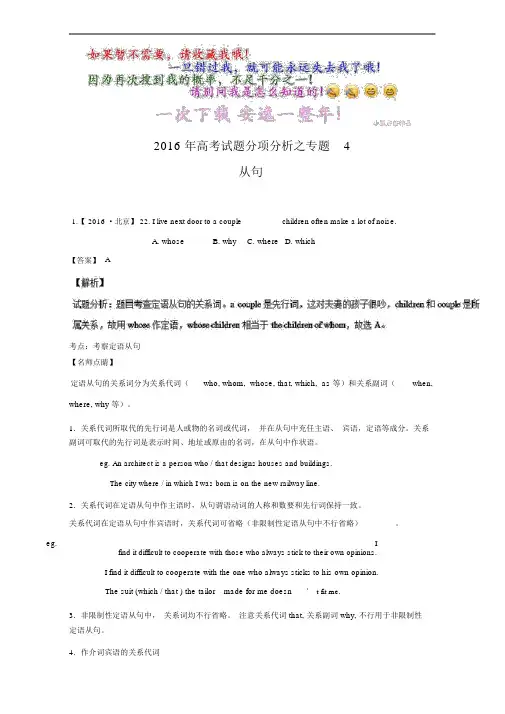
2016 年高考试题分项分析之专题 4从句1.【 2016 ·北京】 22. I live next door to a couple ________ children often make a lot of noise.A. whoseB. whyC. whereD. which【答案】 A考点:考察定语从句【名师点睛】定语从句的关系词分为关系代词(who, whom, whose, that, which, as 等)和关系副词(when, where, why 等)。
1.关系代词所取代的先行词是人或物的名词或代词,并在从句中充任主语、宾语,定语等成分。
关系副词可取代的先行词是表示时间、地址或原由的名词,在从句中作状语。
eg. An architect is a person who / that designs houses and buildings.The city where / in which I was born is on the new railway line.2.关系代词在定语从句中作主语时,从句谓语动词的人称和数要和先行词保持一致。
关系代词在定语从句中作宾语时,关系代词可省略(非限制性定语从句中不行省略)。
eg.Ifind it difficult to cooperate with those who always stick to their own opinions.I find it difficult to cooperate with the one who always sticks to his own opinion.The suit (which / that ) the tailor made for me doesn’ t fit me.3.非限制性定语从句中,关系词均不行省略。
注意关系代词 that, 关系副词 why, 不行用于非限制性定语从句。
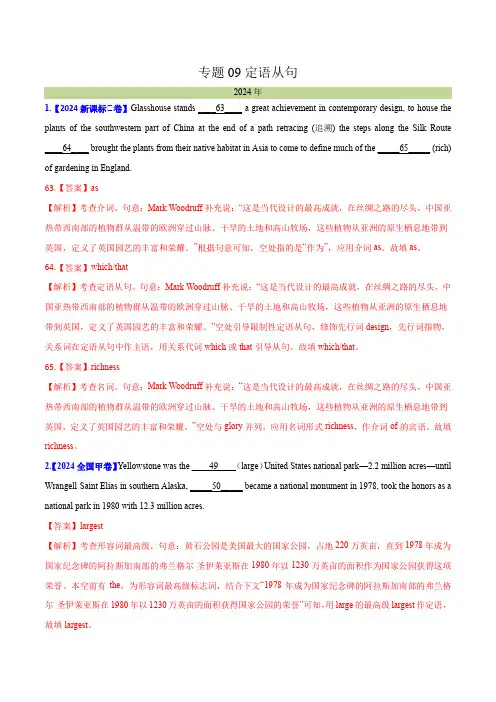
专题09定语从句2024年1.【2024新课标Ⅰ卷】Glasshouse stands ____63____ a great achievement in contemporary design, to house the plants of the southwestern part of China at the end of a path retracing (追溯) the steps along the Silk Route ____64____ brought the plants from their native habitat in Asia to come to define much of the _____65_____ (rich) of gardening in England.63.【答案】as【解析】考查介词。
句意:Mark Woodruff补充说:“这是当代设计的最高成就,在丝绸之路的尽头,中国亚热带西南部的植物群从温带的欧洲穿过山脉、干旱的土地和高山牧场,这些植物从亚洲的原生栖息地带到英国,定义了英国园艺的丰富和荣耀。
”根据句意可知,空处指的是“作为”,应用介词as。
故填as。
64.【答案】which/that【解析】考查定语从句。
句意:Mark Woodruff补充说:“这是当代设计的最高成就,在丝绸之路的尽头,中国亚热带西南部的植物群从温带的欧洲穿过山脉、干旱的土地和高山牧场,这些植物从亚洲的原生栖息地带到英国,定义了英国园艺的丰富和荣耀。
”空处引导限制性定语从句,修饰先行词design,先行词指物,关系词在定语从句中作主语,用关系代词which或that引导从句。
故填which/that。
65.【答案】richness【解析】考查名词。
句意:Mark Woodruff补充说:“这是当代设计的最高成就,在丝绸之路的尽头,中国亚热带西南部的植物群从温带的欧洲穿过山脉、干旱的土地和高山牧场,这些植物从亚洲的原生栖息地带到英国,定义了英国园艺的丰富和荣耀。
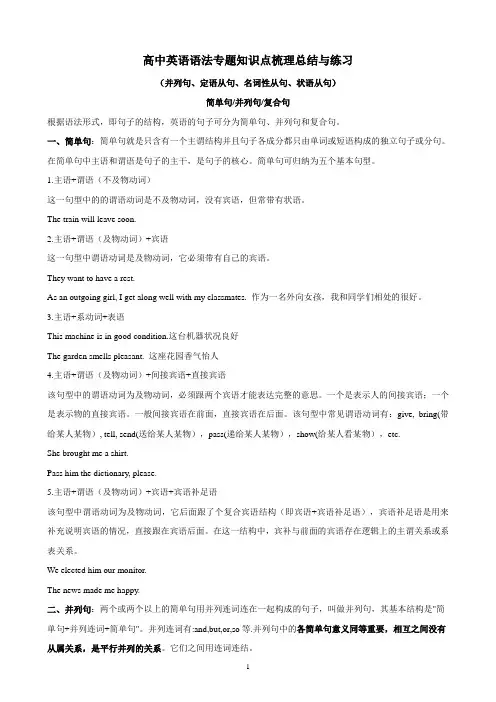
高中英语语法专题知识点梳理总结与练习(并列句、定语从句、名词性从句、状语从句)简单句/并列句/复合句根据语法形式,即句子的结构,英语的句子可分为简单句、并列句和复合句。
一、简单句:简单句就是只含有一个主谓结构并且句子各成分都只由单词或短语构成的独立句子或分句。
在简单句中主语和谓语是句子的主干,是句子的核心。
简单句可归纳为五个基本句型。
1.主语+谓语(不及物动词)这一句型中的的谓语动词是不及物动词,没有宾语,但常带有状语。
The train will leave soon.2.主语+谓语(及物动词)+宾语这一句型中谓语动词是及物动词,它必须带有自己的宾语。
They want to have a rest.As an outgoing girl, I get along well with my classmates. 作为一名外向女孩,我和同学们相处的很好。
3.主语+系动词+表语This machine is in good condition.这台机器状况良好The garden smells pleasant. 这座花园香气怡人4.主语+谓语(及物动词)+间接宾语+直接宾语该句型中的谓语动词为及物动词,必须跟两个宾语才能表达完整的意思。
一个是表示人的间接宾语;一个是表示物的直接宾语。
一般间接宾语在前面,直接宾语在后面。
该句型中常见谓语动词有:give, bring(带给某人某物), tell, send(送给某人某物),pass(递给某人某物),show(给某人看某物),etc.She brought me a shirt.Pass him the dictionary, please.5.主语+谓语(及物动词)+宾语+宾语补足语该句型中谓语动词为及物动词,它后面跟了个复合宾语结构(即宾语+宾语补足语),宾语补足语是用来补充说明宾语的情况,直接跟在宾语后面。
在这一结构中,宾补与前面的宾语存在逻辑上的主谓关系或系表关系。
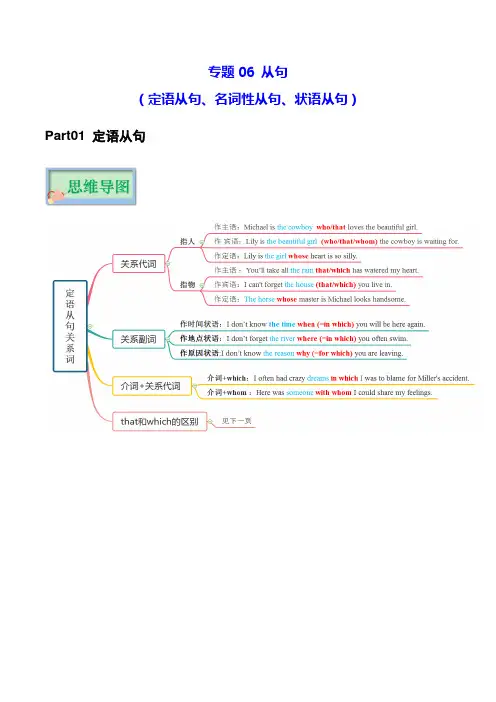
专题06 从句(定语从句、名词性从句、状语从句)Part01 定语从句1:考点梳理1.引导定语从句的关系词;1.限制性与非限制性定语从句的区别;2.“介词+关系代词”的结构;3.关系词之间的异同及选用。
考点1定语从句的种类(1)限制性定语从句从句在句中是不可缺少的部分,去掉后主句意思往往不明确,与主句之间不用逗号隔开。
This is the house which we bought last month.(2)非限制性定语从句从句是对主句或先行词的补充和说明,去掉后不影响主句的意思,与主句之间往往用逗号隔开。
The house, which we bought last month, is very nice.当先行词是专有名词或被物主代词/指示代词所修饰时,其后的定语从句通常是非限制性的。
Charles Smith, who was my former teacher, retired last year.My house, which I bought last year, has got a lovely garden.非限制性定语从句还能将整个主句作为先行词,对其进行修饰,这时从句谓语动词要用第三人称单数。
He seems not to have grasped what I meant, which greatly upsets me.考点2 关系代词与关系副词关系词先行词从句成分例句备注关系代词who 人主语Do you know the man who is talking with your mother?whom,which和that在从句中作宾语时,常可以省略,但介词提前时后面关系代词不能省略,也不可以用thatwhom 人宾语Mr Smith is the person with whom I am working.The boy (whom) she loved died in the war.whose 人、物定语I like those books whose topics are about history.The boy whose father works abroad is my deskmate.that 人、物主语、宾语A plane is a machine that can fly.She is the pop star (that) I want to see very much.which 物主语、宾语The book (which) I gave you was worth $10.The picture which was about the accident was terrible.as 人、物主语、宾语He is such a person as is respected by all of us.This is the same pen as I lost yesterday.as作宾语一般不省略关系副词when 时间时间状语I will never forget the day when we met there.可用on which替换where 地点地点状语This is the house where I was born.可用in which 替换why 原因原因状语I can’t imagine the reason why he turned down my offer.可用for which替换考点3关系代词that和which的特殊用法1. 限制性定语从句中,只用关系代词that的情况:(1)先行词是all, everything, anything, nothing, little, much, few等不定代词。
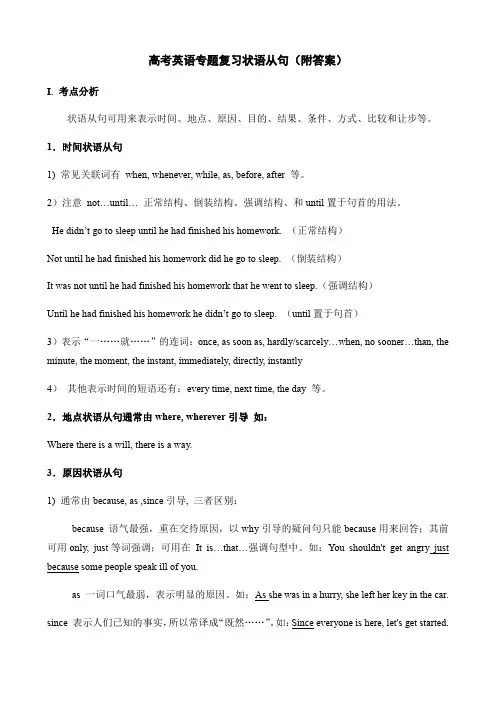
高考英语专题复习状语从句(附答案)I. 考点分析状语从句可用来表示时间、地点、原因、目的、结果、条件、方式、比较和让步等。
1.时间状语从句1) 常见关联词有when, whenever, while, as, before, after 等。
2)注意not…until… 正常结构、倒装结构、强调结构、和until置于句首的用法。
He didn’t go to sleep until he had finished his homework. (正常结构)Not until he had finished his homework did he go to sleep. (倒装结构)It was not until he had finished his homework that he went to sleep.(强调结构)Until he had finished his homework he didn’t go to sleep. (until置于句首)3)表示“一……就……”的连词:once, as soon as, hardly/scarcely…when, no sooner…than, the minute, the moment, the instant, immediately, directly, instantly4)其他表示时间的短语还有:every time, next time, the day 等。
2.地点状语从句通常由where, wherever引导如:Where there is a will, there is a way.3.原因状语从句1) 通常由because, as ,since引导, 三者区别:because 语气最强,重在交待原因,以why引导的疑问句只能because用来回答;其前可用only, just等词强调;可用在It is…that…强调句型中。
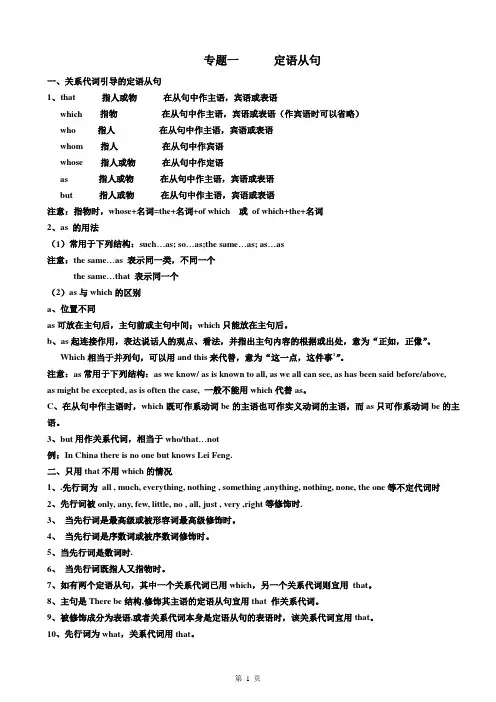
专题一定语从句一、关系代词引导的定语从句1、that 指人或物在从句中作主语,宾语或表语which 指物在从句中作主语,宾语或表语(作宾语时可以省略)who 指人在从句中作主语,宾语或表语whom 指人在从句中作宾语whose 指人或物在从句中作定语as 指人或物在从句中作主语,宾语或表语but 指人或物在从句中作主语,宾语或表语注意:指物时,whose+名词=the+名词+of which 或of which+the+名词2、as 的用法(1)常用于下列结构:such…as; so…as;the same…as; as…as注意:the same…as 表示同一类,不同一个the same…that 表示同一个(2)as与which的区别a、位置不同as可放在主句后,主句前或主句中间;which只能放在主句后。
b、as起连接作用,表达说话人的观点、看法,并指出主句内容的根据或出处,意为“正如,正像”。
Which相当于并列句,可以用and this来代替,意为“这一点,这件事’”。
注意:as常用于下列结构:as we know/ as is known to all, as we all can see, as has been said before/above, as might be excepted, as is often the case, 一般不能用which代替as。
C、在从句中作主语时,which既可作系动词be的主语也可作实义动词的主语,而as只可作系动词be的主语。
3、but用作关系代词,相当于who/that…not例:In China there is no one but knows Lei Feng.二、只用that不用which的情况1、.先行词为all , much, everything, nothing , something ,anything, nothing, none, the one等不定代词时2、先行词被only, any, few, little, no , all, just , very ,right等修饰时.3、当先行词是最高级或被形容词最高级修饰时。
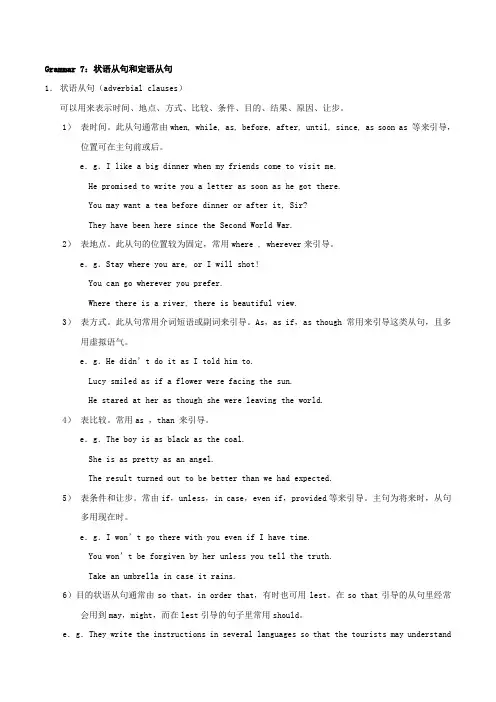
Grammar 7:状语从句和定语从句1.状语从句(adverbial clauses)可以用来表示时间、地点、方式、比较、条件、目的、结果、原因、让步。
1)表时间。
此从句通常由when, while, as, before, after, until, since, as soon as 等来引导,位置可在主句前或后。
e.g.I like a big dinner when my friends come to visit me.He promised to write you a letter as soon as he got there.You may want a tea before dinner or after it, Sir?They have been here since the Second World War.2)表地点。
此从句的位置较为固定,常用where , wherever来引导。
e.g.Stay where you are, or I will shot!You can go wherever you prefer.Where there is a river, there is beautiful view.3)表方式。
此从句常用介词短语或副词来引导。
As,as if,as though 常用来引导这类从句,且多用虚拟语气。
e.g.He didn’t do it as I told him to.Lucy smiled as if a flower were facing the sun.He stared at her as though she were leaving the world.4)表比较。
常用as ,than 来引导。
e.g.The boy is as black as the coal.She is as pretty as an angel.The result turned out to be better than we had expected.5)表条件和让步。
2018 年高考英语真题分类汇编专题 07:宾语从句、状语从句和定语从句一、单项选择题(共7 题;共 14 分)1.(2018?天津) The gold medal will be awarded to ___________ wins the first place in the bicycler.A. whomeverB. whereverC. whoeverD. whatever2(.2018?江苏)_______ you can sleep well, you will lose the ability to focus, plan and stay motivated after one or two nights.A. OnceB. UnlessC. IfD. When3.(2018?江苏) Self-driving is an area _______ China and the rest of the world are on the same starting line.A. thatB. whereC. whichD. when4.(2018?北京) _________ we don't stop climate change, many animals and plants in the world will be gone.5.(2018?北京) She and her family bicycle to work, _________ helps them keep fit.A. whichB. whoC. asD. that6.(2018?天津) Let's not pick these peaches until this weekend ___________they get sweet enough to be eaten.A. ever sinceB. as ifC. even thoughD. so that7.(2018?天津) Kae, _________sister I shared a room with when we were at college, has gone to work in Australia.A. whomB. thatC. whoseD. her2018 年高考英语真题分类汇编专题08:其余种类句式一、单项选择题(共5 题;共 10 分)1.(2018?北京) Without his support, we wouldn't be _________ we are now.A. howB. whenC. whereD. why【答案】 C【考点】表语从句1 / 5【分析】【剖析】句意:没有他的支持,我不可以抵达在的地步。
专题09 定语从句养成良好的答题习惯,是决定高考英语成败的决定性因素之一。
做题前,要认真阅读题目要求、题干和选项,并对答案内容作出合理预测;答题时,切忌跟着感觉走,最好按照题目序号来做,不会的或存在疑问的,要做好标记,要善于发现,找到题目的题眼所在,规范答题,书写工整;答题完毕时,要认真检查,查漏补缺,纠正错误。
总之,在最后的复习阶段,学生们不要加大练习量。
在这个时候,学生要尽快找到适合自己的答题方式,最重要的是以平常心去面对考试。
英语最后的复习要树立信心,考试的时候遇到难题要想“别人也难”,遇到容易的则要想“细心审题”。
越到最后,考生越要回归基础,单词最好再梳理一遍,这样有利于提高阅读理解的效率。
另附高考复习方法和考前30天冲刺复习方法。
2023年1.【2023年全国乙卷】But for all its ancient buildings, Beijing is also a place ____43____ welcomes the fast-paced development of modern life, with 21st-century architectural ____44____ (wonder) standing side by side with historical buildings of the past.s【43题详解】考查定语从句。
句意:但是,除了古建筑,北京也是一个欢迎现代生活快节奏发展的地方,21世纪的建筑奇迹与过去的历史建筑并存。
这里为定语从句的关系代词,先行词为“a place”,在定语从句中担当主语,所以用关系代词which或that引导。
故填which/that。
【44题详解】考查名词。
句意:但是,除了古建筑,北京也是一个欢迎现代生活快节奏发展的地方,21世纪的建筑奇迹与过去的历史建筑并存。
分析句子成分可知,空处为名词形式;根据下文的“historical buildings of the past”可知,空处为名词的复数形式。
高考英语语法专题复习分类汇编定语从句与状语从句一.定语从句Julia was good at German, French and Russian, all of she spoke fluently. (2011·湖南卷25)A. whoB. whomC. whichD. that【解析】选C。
前面谈到了3 种语言即German,French 和Russian,它们为先行词。
all of which =of which all=and all of them,作非限定性定语从句。
考点 1.限制性定语从句和非限制性定语从句的比较:限制性定语从句非限制性定语从句形式其前无逗号其前有逗号翻译译在先行词前(即:从句译作先行词的定语)译成与主句并列的一个分句(即:译作两句)功能修饰名词或代词可修饰名词或代词,也可修饰整个主句关系词可用that 引导;作宾语的关系代词常可省不可用that 引导;关系词一律不省意义起限制作用(若被省去,原句意义不完整)起补充说明作用(若被省去,原句意义不受影响)考点2.介词+关系代词连用时,介词的选用She showed the visitors around the museum, the construction had taken more than three years. (2011·江西卷34)A. for whichB. with whichC. of whichD. to which【解析】选C。
博物馆的建设花了3 年多时间。
我们可以说whose construction,也可以说the construction of which=of which the construction,介词of 表所属关系。
介词提前时,定语从句的形式为:介词+which/whom, 不能用that 或who。
介词的选用一般根据后边动词与介词的搭配关系选择。
考点3.as 和which 引导非限制性定语从句的比较例1:Ted came for the weekend wearing only some shorts and a T-shirt, is a stupid thing to do in such weather. (2011·全国大纲卷7)A. thisB. thatC. whatD. which【解析】选D。
which 引导非限定性定语从句。
代指前句整个内容。
例2:is know to everybody, the moon travels round the earth once every month.A. ItB. AsC. ThatD. What【解析】选B。
A、D 不能引导定语从句,C 不能引导非限定性定语从句。
As is known to everybody=As everybody knows “正如大家所知道的”。
该句也可换成It is known to everybody that the moon travels round the earth once every month. =What is known to everybody is that the moon travels round the earth once every month.as 和which 的相同点:(1) 先行词都可指代整个主句;(2) 都可在从句中作主语、宾语或表语。
as 和which 的不同点:(1) as 引导的从句可位于句首,而which 则不行;(2) as 有“正如……”之意,而which 表示“这一点”。
考点4.关系代词与关系副词的选用I will never forget the day I came to my university and the day I spent in a new city.A. when; whichB. which; whenC. what; thatD. on which; when【解析】选A。
第一个时间名词the day 在从句中作状语,因此要用关系副词when;第二个时间名词the day 在从句中作动词spent 的宾语,因此要用关系代词which 或that 来引导定语从句或省略关系代词。
如果先行词是时间、地点或理由,而引导词在从句中作时间、地点、原因等状语时,引导词用when, where, why;有时尽管先行词是时间、地点或理由,但是引导词在从句中不作状语,而是作主语、宾语或表语,引导词则用that 或which。
Men are more suited to occupational environments require decisive action while women are better at jobs a considered approach is most important. (江苏南京金陵中学高三第4 次模拟卷)A. which; thatB. /; whenC. which; whenD. that; w here【解析】选D。
第一空用关系代词that 或which 作主语,不可以省略。
第二空用关系副词where,因为句子意思完整,不缺主语或宾语。
根据先行词job 和定语从句意思,确定用关系副词where=at which 表地点,作地点状语。
定语从句中如果先行词是地点,而引导词在从句中可作地点状语,引导词用where;如果先行词是时间,而引导词在从句中可作时间状语,引导词用when。
考点5.定语从句与同位语从句与强调句型的区别Was it in the street our school is located in the car accident happened?A. where; thatB. where; whichC. that; whichD. which; that【解析】选D。
本题考查定语从句和强调句型。
第一空考查定语从句,that 或which 作第二个in 的宾语;第二空考查强调句型。
1. 区别定语从句与同位语从句最简单的方法是:在先行词与从句之间加be 动词,若句子成立,则是同位语从句;若句子不成立,则可能为定语从句。
The news that he has passed the exam pleased him and his family.由于“The news is that he has passed the exam.”句子成立,因此“that he has passed the exam”是The news 的同位语。
The news that he told me this morning is not interesting.由于“The news is that he told me this morning”不成立,于是“that he told me this morning”不是The news 的同位语,而是限定The news 的定语从句。
2. 区别定语从句与强调句最简单的方法是:若将It is / was 和that / who 去掉而句中不缺成分,结构完整,说明原句是强调句型;若结构不完整,则说明原句可能为定语从句。
状语从句分为时间、地点、原因、条件、让步、结果、目的、方式及比较状语从句。
二.状语从句考点1.when, while, as 引导时间状语的特殊点You can pay now or you come back to pick up the bike.A. whenB. thenC. whileD. since【解析】选A。
come 是短暂性动词,而while 从句的谓语动词必须是延续性的,所以排除C, when 引导时间状语从句,与now 对称。
1. 表示带有规律性的“每当”或从句和主句的动作存在先后关系时,一般用when。
2. 表达“随着”或“一边……一边……”的含义,一般用as。
3. as 作“当……时候”解,从句的谓语一般不可是状态动词。
4. while 从句的谓语动词不可是短暂性的。
考点2.时间、条件状语从句的时态一致性例1:The big fire lasted as long as 24 hours it was brought under control. (ft西太原五中2010— 2011 学年度第二学期月考)A. afterB. beforeC. aheadD. since【解析】选B。
before 引导时间状语从句用于以下句型:①时间段+before 从句表示“隔了多少时间才…”;②it will be/ won't be long before 从句,表示“很久就……/不久就……”。
该句表示:大火一直持续了长达24 小时才被控制住。
例2:As is reported, it is 100 years Qinghua University was founded. (2011·四川卷6)A. whenB. beforeC. afterD. since【解析】选D。
该句考查句型it is/has been +时间段+since 从句。
句意:清华大学已成立了100 年了。
since 从句后的动词一般为非延续性动词,表动作的开始。
1. 句型“It will be+段时间+before 从句”,表示“不久……就……”。
从句用一般现在时代替一般将来时。
2. 句型“It is+段时间+since+一般过去时。
”主句常用现在完成时,从句常用一般过去时。
若从句谓语动词是延续性的,表示动作的终止;若从句谓语动词是短暂性的,则表示动作的开始。
考点3. as 引导状语从句的用法例1:Try she might, Sue couldn't get the door open. (2011·新课标卷22)A. ifB. whenC. sinceD. as【解析】选D。
as 引导让步状语从句。
Try as she might=Though she might try,该句型主要有以下几种形式:①零冠词名词+as +主语+be ②形容词(+名词)+as +主语+be ③动词原形+as+主语+情态动词as 引导原因状语从句说明原因语气较弱,着重点在主句,常译为“由于,因为”。
例2:he was, he often ended up in financial troubles.A. Though well paidB. As well paidC. Well paid asD. Well paid【解析】选C。